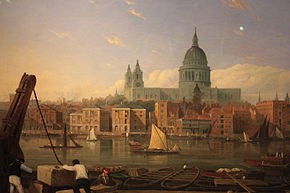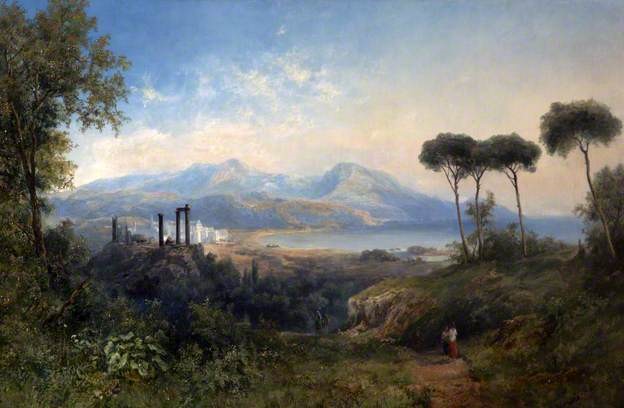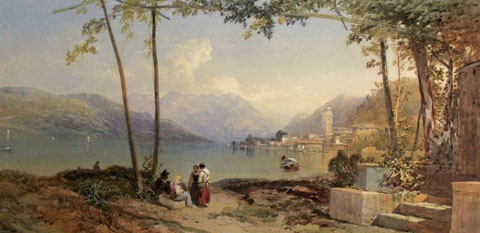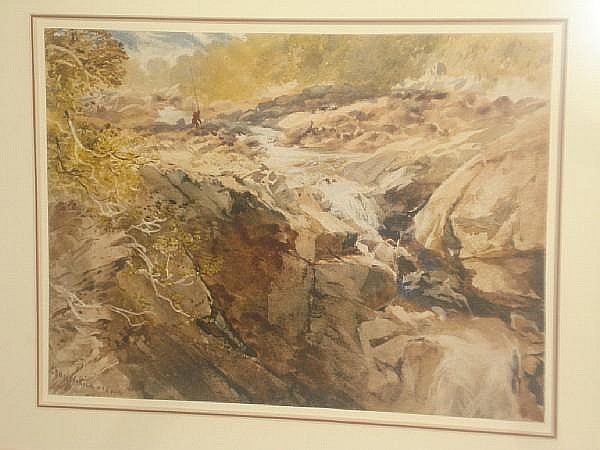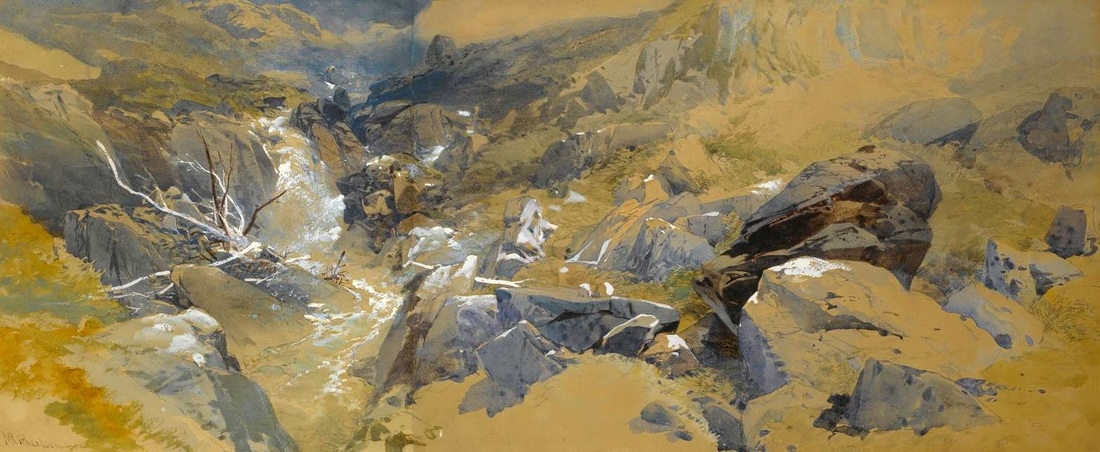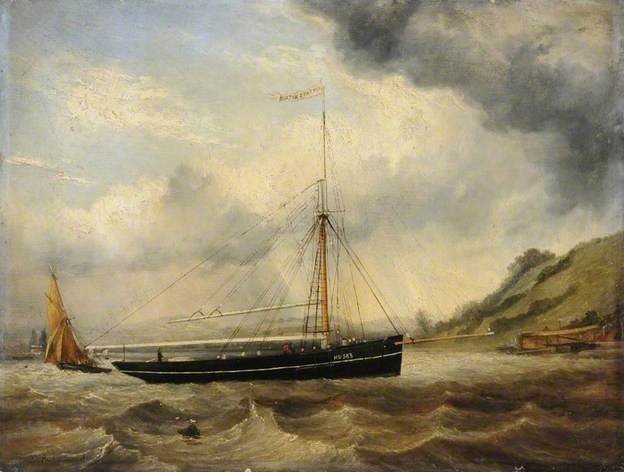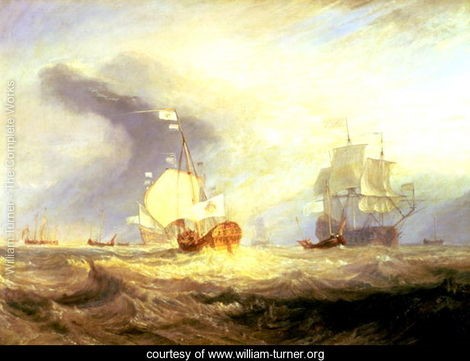On the Esk, Near Whitby
|
Research by Sue Cannon
|
|
Acc No 161
Artist Charles Richardson Artist dates 1829-1908 Medium watercolour Size 17.78 x 34.29 cm (7 x 13.5 in) Date painted unknown Donor R Eckersley Bequest, Haulgh Mount Headroomgate Rd, St Annes Date donated 20 March 1944 Note: Richard Eckersley also donated Sheep and Goat, oil, by Alfred Morris |
|
PAINTING
The viewer is at eye level, low down or standing in the water at the centre of the composition, possibly on a boat, a low platform, or even fishing? The still, calm river flows across the whole of the foreground to the edge of the canvas. We are looking directly towards the distant horizon where the river disappears at the focal point, which is at the top of the chimney on the house roof, partially hidden by the surrounding trees. We are guided into and through the scene by the enclosed banking, masking buildings hidden by trees and shrubbery on the right of the picture. On the banking on the left side frame there are trees in the middle ground, which reminds us this is land locked water and not the open sea. The sky is clear and bright but not sunny, reflecting and duplicating the same pale colour in the water. The muted tones of greens and blues against the hints of pinkish-brown warmth in the brick buildings emphasises the lack of sunlight. It could be early morning or late evening in this empty stillness. The delicate use of brush marks creates clumps of grasses dancing rhythmically across the canvas, growing out of the shallow water and along the edges of the banking, emphasising space and the natural wildness of the location, nature takes over. The land meanders in and out, forming small harbours for the water to overflow onto the land in this very English country scene. Space and perspective are created by the open water of the foreground and large clumps of grasses slightly blocking our path as they grow up and out of the water, subtly guiding our eyes to the middle ground trees and on to the distant horizon. The roaming embankment winding in and out of the middle ground to the sides of the composition, together with the spiky feathery marks of the grasses, take our eyes in and out, across, through, and into the scene before us. We are the only people in this still, calm, spacious scene, undisturbed by sight or sound of any busy world that may be asleep, nestled and hidden by the protective trees. ARTIST Charles Richardson was a landscape and seascape painter in oil and watercolour in the traditional English and Victorian style. He was born in 1829 in Newcastle, a middle son of T M Richardson Snr. He practised as a professional artist and drawing master in Newcastle after having received tuition by his father and his elder brother, Henry Burdon Richardson, as well as his more successful brother, Thomas Miles Richardson. He exhibited extensively in Newcastle and at the Suffolk Street Gallery, London. In addition, he exhibited regularly at the Royal Academy between 1856 and 1901, showing some 28 works. (1) His father was a prominent painter and teacher who was one of the most highly regarded painters of watercolours produced in the North East of England. Also born in Newcastle, his father showed a passionate love for drawing from early childhood. He became drawing master at St Andrew's Free School, Newcastle, and later took a passage, by ship, to London where he became acquainted with some of the best work of British artists, including David Cox. (2) At first his father’s work attracted little interest in Newcastle, but after his painting A View of Newcastle Fish Market was accepted by the Royal Academy he began to exhibit at the British Institution. Richardson Snr, together with a small group of amateur and professional artists, started ‘The Northumberland Institution for the Promotion of Fine Arts’ in 1822, which eventually, in 1828, became ‘The Northern Academy of Arts’, bringing them in line with the academies of London and Edinburgh. They held their first Exhibition, which included work by J M W Turner (1775–1851), in June 1828. Along with other well known artists he also helped set up ‘The Northern Society of Painters in Water Colours’ in 1830; this society became a meeting place for a number of talented watercolourists. As well as being a primary force in the artistic development of early 19th century Newcastle, he is also notable as the father of the Richardson family of painters. His sons, Thomas Miles, Henry Burdon, Edward, Charles, George and John Isaac all became professional painters. (3) Thomas Miles Richardson Snr (1784–1848), English landscape painter
Young Charles would have grown up in this atmosphere, soaking in the history of art and composition alongside the classical academic training he was given by the family. He was influenced by the most famous late Italian Baroque art of French artist, Claude Lorrain, as can be seen in his classical landscape painting, In the Mediterranean, below. Here, Charles Richardson draws inspiration from the Greek and Roman ruins of the Mediterranean. The painting is an imaginary scene representing the classical era. It may have been inspired by the painter’s year-long stay in a villa overlooking the Bay of Naples and the Sorrento Peninsula in Italy during 1881. (5)
We see those same influences in T M Richardson Jnr's painting, A Continental Lake View.
We can also see the extensive tours taken of the Highlands and the Swiss and Italian Alps reflected in his work. These scenes and views were amongst his favourite subjects, as they were of his younger brother, Charles. In fact, by comparing a number of paintings by the brothers it is possible to imagine that they toured and painted together, as they produced similar scenes of almost the same moments in time
- see Angler on a Waterfall and A Rocky Stream in Scotland below. (9) T M Richardson’s A Rocky Stream in Scotland. Pencil and watercolour, heightened with white, on two joined sheets of buff paper, signed T M Richardson (lower left),
size 345 x 845 mm, National Gallery of Scotland, Edinburgh. The famous artist, writer, critic and supporter of the Pre-Raphaelite movement, John Ruskin, could be a little controversial when discussing T M Richardson’s work, suggesting,
'Mr Richards (sic) is gradually gaining in manual power, and opposes cobolt and burnt sienna very pleasantly. But he seems always to conceive a Highland landscape only as a rich medley of the same materials - a rocky bank, blue at one place and brown at another: some contorted Scottish firs, some ferns, some dogs and some sportsmen: the whole contemplated under the cheering influence of champagne and considered in every (website 'very') way delightful. (10) However, drawing the attention of John Ruskin for whatever reason would in itself be a compliment to the artist. Indeed, that Ruskin saw fit to comment would be enough within artistic circles. We can also see the influence of another great seascape artist on Charles Richardson’s work, that of J W M Turner. Turner’s fascination for the power of the sea and nature’s elements can be seen at work within Turner’s composition of Admiral Von Trumps Barge. In Charles Richardson’s seascape, Untitled, we see him capture the power of the sea set against a stormy sky. Turner's painting Admiral Von Trumps Barge (at the entrance to Texel in 1645). (12) Although a great deal is not known of Charles Richardson’s life, he was evidently a success alongside his five brothers, which in itself is unusual - so many talented artists in one family. He enjoyed a career as an artist in his own lifetime, which enabled him to focus on his painting and travel. Most of his work is in private collections.
DONOR The donor, Richard Ernest Eckersley, was born in Salford, Manchester in 1877. In 1881 and in 1891 he was living with his parents, Benjamin and Annie, in south Manchester. In 1901, living with his widowed mother, he was described as a bank clerk and in the 1911 census as a sub-manager. He remained unmarried, residing with his mother and grandmother. The next reference to his address was in 1924 when it was given as Haulgh Mount, Headroomgate, St Annes. He died in 1944, aged 68. Several paintings were left to Lytham St Annes Borough Council in his Will. |
REFERENCES
(1) http://www.johnnicholsonfineart.co.uk/department/charles-richardson-landscape-and-seascape-painter-oil-watercolour/ (2) http://www.johnnicholsonfineart.co.uk/department/richardson_thomas_miles_snr_1784-1848_/ (3) http://www.gillhedley.co.uk/pdf/19c-Newcastle-artists.pdf (4) http://en.wikipedia.org/wiki/Thomas_Miles_Richardson (5) http://www.artble.com/artists/claude_lorrain text (6) http://www.bbc.co.uk/arts/yourpaintings/paintings/in-the-mediterranean image (7) http://www.nationalgallery.org.uk/paintings/claude-landscape-with-hagar-and-the-angel image (8) http://www.johnnicholsonfineart.co.uk/product/a_continental_lake_view/ (9) http://www.invaluable.co.uk/auction-lot/charles-richardson-british,-1829-1908-angler-on-863-c-11b4ff337e (10) http://www.stephenongpin.com/Thomas-Miles-Richardson-Junior-1813-1890-Rocky-Stream-Scotland-DesktopDefault.aspx?tabid=6&tabindex=5&objectid=616690 (11) http://www.bbc.co.uk/arts/yourpaintings/artists/c-richardson (12) http://www.william-turner.org/Admiral-von-Trumps-Barge-at-the-Entrance-of-the-Texel-in- 1645,-c.1831.html |

